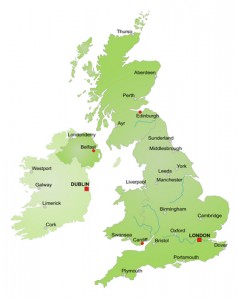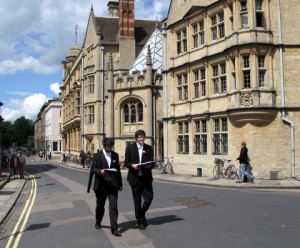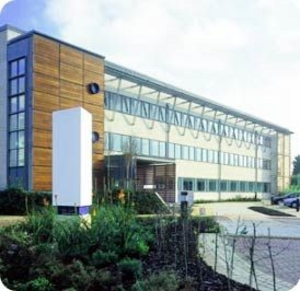
[Last updated March 2023] A guide to serviced offices and office space for rent in Oxford as well as general information that may be useful if you are thinking of renting office space in the city.
For further offices information or to search office space for rent in Oxford just click. Or contact us for any other office space query.
History & Geography
One of England’s most famous cities, Oxford is located in the south of the country approximately 50 miles north of London. Running through the city are the rivers Cherwell and Thames, which meet each other south of the city centre. Oxford was first settled after the arrival of the Saxons in England and originally bore the name Oxenaforda, meaning ‘Ford of the Oxen’. By the tenth century, the town had been fortified due to sporadic attacks by the Danes, and the fact that it was on the sometimes disputed frontier between Mercia and Wessex. During the Norman invasion in the 11th century the town was heavily damaged during the fighting, however, was quickly rebuilt. The Normans then built Oxford Castle in the city to ensure it remained loyal. Subsequently, the town continued to prosper but failed to grow significantly. It did however start to acquire a reputation as a centre of knowledge and learning. In 1139, Geoffrey of Monmouth wrote History of the Kings of Britain. The city’s famous university was founded in the 12th century, and by the 13th century, the university’s colleges were being formed, including University College, Balliol and Merton. It was in these colleges that the writings of the Greek philosophers were translated and that scholars strove to reconcile the tenants of Greek philosophy and Christian Theology. During the English Civil War, Charles I had his court in Oxford after being expelled from London, despite the fact that much of the city supported the Parliamentarians. The city was besieged and eventually surrendered to the Parliamentary army under Thomas Fairfax. In 1790, the Oxford Canal was built, connecting the city to Coventry and thereby enhancing trade links between the cities. The 19th century saw the city expand and the construction of Oxford Town Hall. With the advent of the 20th century, the city grew rapidly and the industries of printing and publishing became important. The establishment of the Morris Motor Company car works also changed the nature of the town, swelling the population. A later influx of immigrants has made Oxford extremely cosmopolitan in nature and it is currently one of the most diverse small cities in the country.
Economy
Oxford has a thriving and fairly diversified economy. Obviously, the university itself, as well as the various research and business projects around it, is a major bulwark of the town’s economy. As one of the most prestigious universities in the world, Oxford routinely attracts visiting professors and academics from all disciplines. Additionally, Oxford has become home to a thriving biotech industry, as well as publishing. The city is also still home to the sizable auto industry, including the manufacturing of vehicle parts. The new Mini is assembled by BMW in Cowley, Oxford, at the Plant Oxford site, a former steel plant. Plant Oxford is the largest employer in Oxfordshire with 3,700 employees who manufacture 900 Minis per day. employees. Oxford also has a fairly large tourist industry, with visitors coming from all over Europe and the world to visit the famous university and see the city’s historic buildings.

Tourism & Culture
Oxford is perhaps the most famous city in England after London, and this is reflected in the almost ten million visitors the city receives every year. As well as the beautiful buildings of the colleges themselves, many tourists visit Carfax Tower and the University Church of St Mary the Virgin, both of which offer stunning views over the city. The city’s historic covered market is also a major draw and dates from the 18th century. The city centre is a major retail hub mostly based around Cornmarket Street, Queen Street, St Aldate’s and The High. Like in its counterpart Cambridge, punting is a popular summer activity in Oxford and the city is also wonderful to walk around, being one of the greenest in England and boasting an array of parks and nature walks within the city itself. Of course, the city also offers a wide range of cultural pursuits, not least of all its museums. Among the most popular and famous are the Ashmolean Museum, the Bodleian Library and the Museum of the History of Science. Art buffs will not want to miss Modern Art Oxford, one of the most respected art museums in the country.
Transportation
Oxford is served by the London Oxford Airport located in Kidlington approximately five miles north of the city. The city itself has an extensive bus system run by Stagecoach and the Oxford Bus Company. Recently hybrid buses have been introduced on several routes. The city’s railway station is approximately half a mile from the city centre and is served by many routes to cities such as Manchester and Edinburgh. Passenger boat services are run down the Thames to Abingdon and further by Salters Steamers.

Office space to rent in Oxford
Much of Oxford’s office space is located outside of town in the popular office parks, such as Oxford Business Park and Oxford Technology Park.
The Oxford office market was hit fairly hard by the economic crisis and annual take-up fell for several years following 2008. During 2012, the headline rent was £21.75 per square foot.
Less than a decade later, the world was hit by another black swan. However, as activity in other office space markets in the UK and around the world suffered, Oxford saw high levels of activity, particularly from occupiers involved with vaccinations.
Take-up in 2020 increased by 5% above 2019 levels. However, 2021 saw take-up increase by a record-breaking 95% to 142,983 square feet.
The majority of those lettings were in the out-of-town town science parks with office space being fashioned for laboratory use.
The demand for lab space has been somewhat detrimental to the office space market as landlords have focused on developing lab space as opposed to office space.
This lack of supply has driven office rents up with out-of-town rents being between £35 and £40 per square foot, and predictions of £60 per square foot in the city centre.
It is hoped that schemes in the development pipeline such as Oxford North will help to satisfy demand and ease the upward pressure on rents.
There are 19 flexible office space providers in Oxford that offer flexible alternatives to leased office space such as private serviced offices, managed office suites and coworking desk space memberships for companies and indivuduals.
The city hosts international office providers such as Regus as well as homegrown Oxford-focused operators such as One St Aldates. Profiles of all providers in Oxford can be seen in this directory.
Our office space search, advisory and acquisition services are FREE, always. Our Oxford office space brokers and agents are globally regulated by the Royal Institution of Chartered Surveyors (RICS) ensuring the highest standards of commercial property advice and service at all times.

The Office Providers is Regulated by the RICS